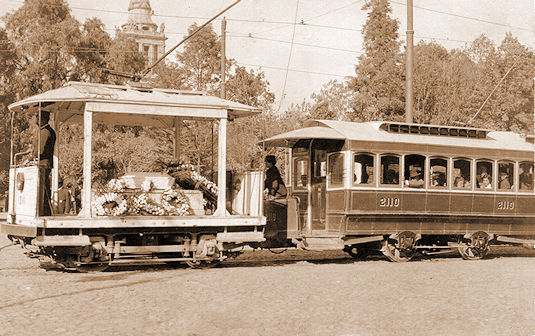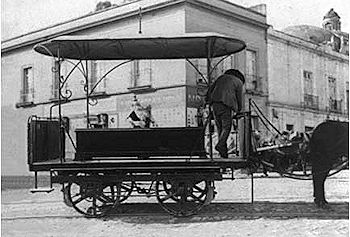

Funeral trams were an unusual feature of Mexico City's public transportation system in the late 19th and early 20th centuries. The earliest cars were pulled by mules (see small view below), later ones electric and pulling trailers. Prices varied according to the facilities and luxury of the service. They were specially designed vehicles that carried coffins and mourners from the city centre to the cemeteries on the western outskirts of Mexico City. The funeral trams had a sombre appearance, originally painted in black, and adorned with curtains and flowers. They also had a bell that rang to announce their passage and clear the way. By 1925 there were 29 funeral motor cars, 27 funeral trailers. The funeral trams operated until the 1930s, when they were replaced by motorized hearses and buses. Our postcard of around 1910 from an unknown local publisher, shows electric car 24 built by J.G.Brill in 1899 on a Brill 21E truck, pulling trailer 2110 which appears to be a former John Stephenson mule/horse tram.
 After earlier mule tramways had opened in 1858 and 1868, in 1878, a new company, the Compañía de Ferrocarriles del Distrito Federal (CFDF), was formed to consolidate and expand the tramway network in the city. The CFDF acquired most of the existing lines and built new ones, reaching a total of 200 kilometres of standard gauge track and 600 cars by 1890. The CFDF also introduced innovations such as double-decker cars, night service, and special fares for workers and students. The CFDF used mostly mules, but also experimented with steam locomotives and cable cars.
After earlier mule tramways had opened in 1858 and 1868, in 1878, a new company, the Compañía de Ferrocarriles del Distrito Federal (CFDF), was formed to consolidate and expand the tramway network in the city. The CFDF acquired most of the existing lines and built new ones, reaching a total of 200 kilometres of standard gauge track and 600 cars by 1890. The CFDF also introduced innovations such as double-decker cars, night service, and special fares for workers and students. The CFDF used mostly mules, but also experimented with steam locomotives and cable cars.
In 1896, the municipal government authorized the CFDF to switch from animal to electric power, the first electric streetcar line was opened in 1900, running from Chapultepec to Tacubaya. The electric trams offered many advantages over the mule trams, such as faster speeds, higher frequencies, better preservation of the streets, and less noise and pollution. However, some mule trams continued to operate until the 1930s, especially in less populated areas or where electric lines were not profitable.
In 1901, a British company registered in London, the Mexico Electric Tramways Ltd (MTC), bought out the CFDF and became the dominant operator of electric trams in the city. The MTC invested heavily in improving and expanding the network, reaching over 800 kilometres of track and 3000 vehicles by 1925.
In 1947, the Mexican government nationalized all tramway companies and created a new public entity, the Servicio de Transportes Eléctricos (STE), to manage them. The STE inherited a large and diverse fleet of trams that ranged from old wooden cars to modern PCC cars. The STE also faced many challenges such as aging infrastructure, rising costs, labour unrest, traffic congestion, and increasing competition from buses, cars, and the metro system, which opened in 1969. The STE tried to modernize and rationalize its services, but could not stop the decline of tram ridership and profitability. In 1984, after several years of closures and reductions of tram lines, the last remaining line was shut down and replaced by a modern light rail line that runs from Tasqueña to Xochimilco.
![]() Go to Postcard Of The Month Index
Go to Postcard Of The Month Index